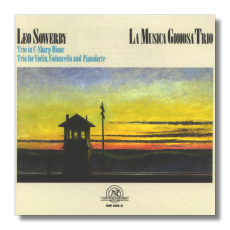
The Internet's Premier Classical Music Source
Related Links
- Sowerby Reviews
- Latest Reviews
- More Reviews
-
By Composer
-
Collections
DVD & Blu-ray
Books
Concert Reviews
Articles/Interviews
Software
Audio
Search Amazon
Recommended Links
Site News
 CD Review
CD Review
Leo Sowerby

Piano Trios
- Trio in C Sharp minor
- Trio for Violin, Violoncello & Pianoforte
La Musica Gioiosa Trio
New World Records NW365-2 69:42
Summary for the Busy Executive: Prodigy and master.
The historicism of music criticism, inherited from the Nineteenth Century, has mauled aesthetic judgment. It pushes criteria like influence, an old-fashioned notion of progress, and heroic resistance against the bourgeoisie. I happen to think Schoenberg a great composer, but not because he influenced a large chunk of other composers. It strikes me as perverse, like valuing Norton and Sackville (Gorboduc) over Shakespeare (The Tempest) or, to go the other way, Edward Albee over Sophocles or Bruckner over Wagner. Most disastrously, historicism builds, in the name of clarity, a curio cabinet with a limited number of bins. What doesn't fit, gets left behind. We come across the discards all the time: Stenhammar, Bloch, Finzi, Holst, Piston, Pettersson, Holmboe, Weill, and so on. Just look at music histories and see who gets left out. It may sometimes happen that a discard's music may so overwhelm listeners, that it gets put into the cabinet. In my lifetime, this happened to Bruckner, Mahler, Nielsen, and Martinů. Of course, some entrepreneur has to take a chance and incur the wrath of those disappointed that the concert didn't include Beethoven.
I don't claim to predict the future, but in the current musical climate, I don't see the Chicago composer Leo Sowerby climbing back into notice any time soon. He hasn't the attraction of historical influence or novelty. You won't likely find him in a textbook or on the next new-music program. Sowerby offers only a powerful sensibility allied to great craftsmanship.
The first notes of the Trio in c# put it firmly in the School of César Franck, except that it's far better written than most of that output, fully the equal of, say, Chausson's Piano Quartet and the Quintet of Franck himself. Its 1911 première astonishes you. Sowerby was 16 years old. Two years later, the Chicago Symphony Orchestra played his Violin Concerto. Really, you have to go back to Mendelssohn to find somebody comparable at so young an age. Sowerby at this point needs no further study with anybody. He just has to find his way. Overall, we see a big, Romantic nature, a love affair with counterpoint and architecture, and absolute technical mastery over idiomatic music for the instruments involved. The first movement – a sonata with four (count 'em, four) themes – impresses by its solid 15-minute span, at least. The composer effortlessly combines and re-combines them. The slow movement unfolds as one long melody – a difficult feat for any composer, let alone a teen-ager. The scherzo is a divertissement and provides a shrewd moment of respite before the hard-charging rondo-tarantella finale. People uncomfortable with Modernism say they wish composers would write like this. Apparently, composers did, even contemporary with Pétrouchka.
The second trio (a third, written around the same time of the first, is lost) appears roughly forty years later. Aside from more advanced, mainly quartal harmony, it shares many large traits with its older sib: imposing structure, contrapuntal gymnastics, and a concern for instruments sounding as good as they can. However, it also benefits from Sowerby's greater experience. The earlier trio sounds rich, but also at times thick, mainly because the young Sowerby can't resist indulging his keyboard virtuosity. Every finger just has to be doing something, and sometimes the piano part makes the strings superfluous. Now, the older, wiser composer shows a greater concern for clarity of ensemble without, I must say, sacrificing any power. Indeed, the work gains on that score, in my opinion. One notices an interesting attempt to fuse baroque forms with classical sonata procedures in the first movement. The work opens very much like a passacaglia, moves to sonata form, and at the end of the development, breaks into fugue on the "passacaglia" subject. That theme is interesting in itself. It breaks into two halves, with the second half the first turned topsy-turvy. This observation isn't confined to an "eye" study of the score. A listener can easily hear it. Indeed, Sowerby constructs a drama based on the symmetry. He treats the halves as one theme as well as breaks them in two and works with them separately. He combines them simultaneously. A second subject provides necessary contrast, but even here the composer can't resist putting both subjects together in what sounds like effortless contrapuntal pyrotechnique. The meditative second movement – largely A-B-A, two quiet sections framing a fiery middle – opens with a gorgeous Hindemithian duet for the two string instruments alone. At the entry of the piano, we get something different, akin to the English Pastoral School. Although the description may strike you as disjointed, in actual performance the movement coheres. The finale begins with the solo piano in a manic tarantella, but soon settles into something else – a sonata-rondo based on a variant of the passacaglia theme of the first movement. Counterpoint abounds, but at a less obvious level. Sowerby aims less to dazzle you than to keep the instruments independent. A work of tremendous integrity.
Karl Davies and Margaret Daly, on violin and cello, do a fine job, especially in the opening duo of the latter trio's second movement. Pianist Gail Quillman, who knew the composer personally, plays with intelligence and fire. Best of all, the three play as a group, with nobody dominating. All three drive the music along. The readings seem to come from one mind.
Copyright © 2009, Steve Schwartz



















